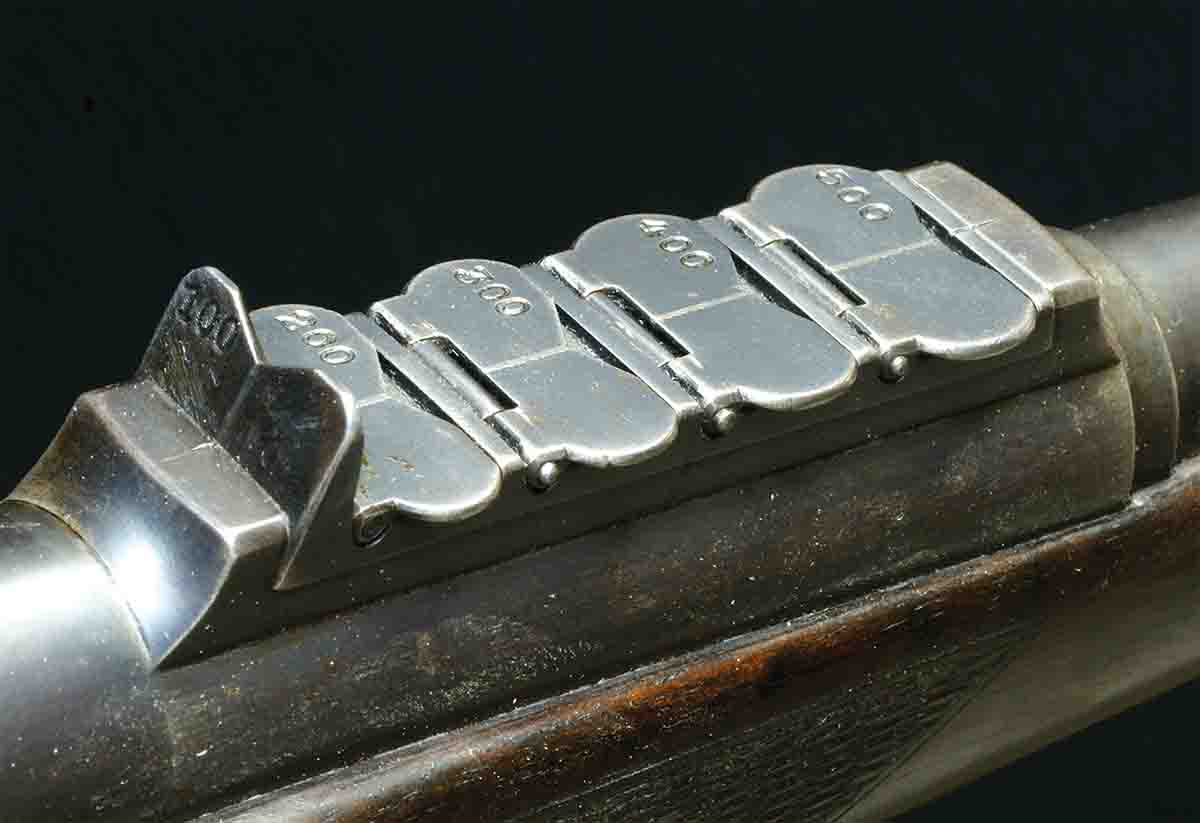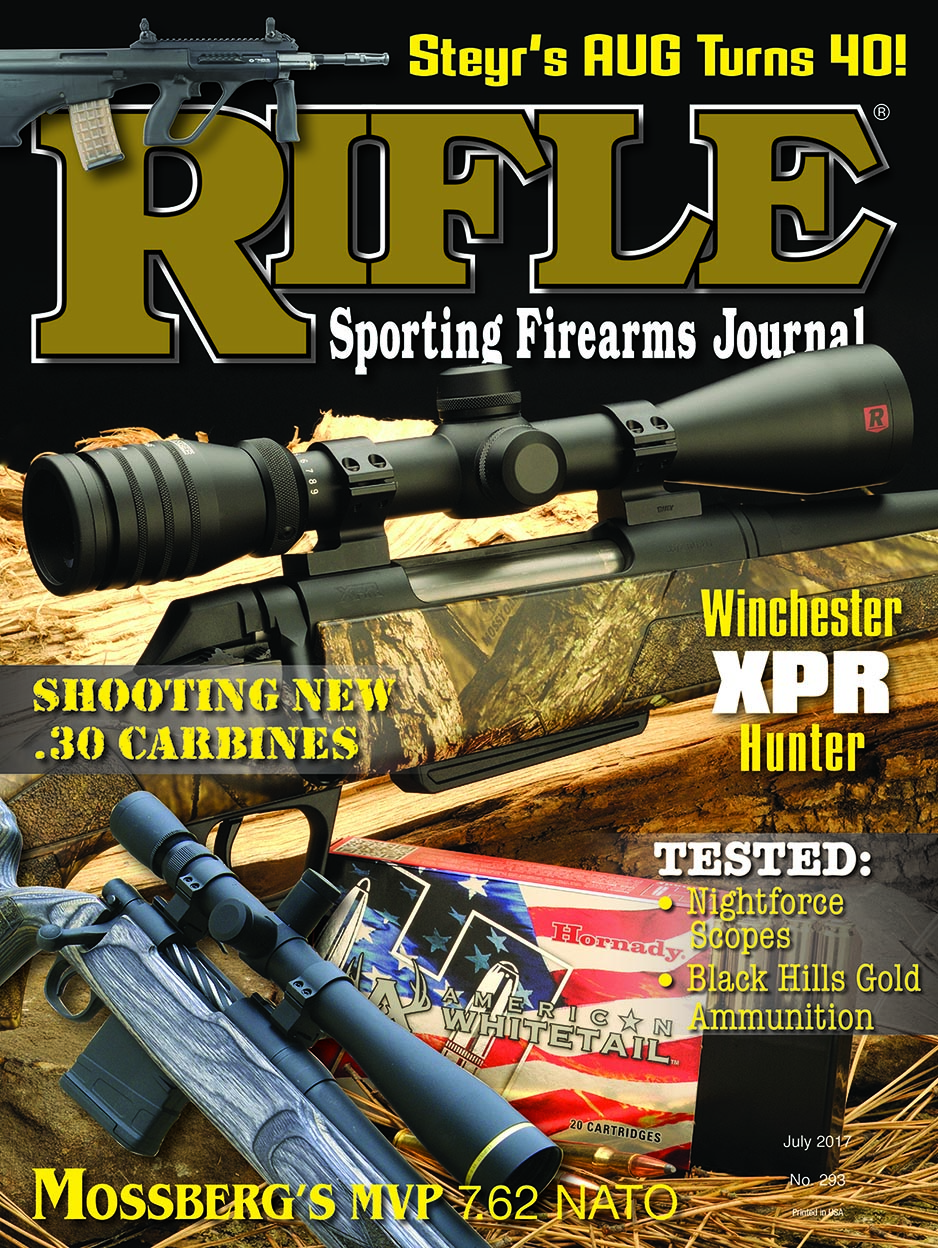Walnut Hill
The Joys of Simplification
column By: Terry Wieland | July, 17

From cuckoo clocks to watches that tell the phases of the moon, there is something in the Teutonic psyche that drives craftsmen to create ever-more-complex mechanisms. The Haenel’s sights are something to behold. It has both open sights on the barrel and a Lyman receiver sight on the action. The front sight, mounted on a ramp, has two blades; when one is pushed down, the other pops up. The rear sight has two folding leaves but no standing leaf. The receiver sight can swing out of the way to allow the open sights to be used. If choosing to use the receiver sight, it has a tiny hinged aperture, giving a choice of two sizes.
The one saving grace of the Haenel is that, in actual use, none of the sighting options get in the way of the others, so even simplicity itself is an option. Compare this with the Ross: It has one front blade and one folding leaf, marked 500 (yards). Chambered for the .280 Ross, the flattest-shooting cartridge of its day, the rifle was effective out to 500 yards. For precise shooting at different distances, the shooter simply sees more of the front sight, or less, in the rear leaf notch, depending on his knowledge of trajectory and his ability to estimate distance. Sir Charles Ross was a serious, life-long deer stalker in the Highlands of Scotland and knew a thing or two about rifles, cartridges and the realities of hunting; he realized the value of simple systems.
The realities of hunting and the realities of selling hunting rifles are not the same thing, however. More rifles are sold to sit on racks and be shown to friends than are sold to be taken up mountains and kill sheep. Some rifle enthusiasts who have never done much hunting imagine that the more choices they have, the better they will be able to shoot when the time comes. In fact, the opposite is true.
In the mid-1980s, I got a letter from a reader in his teens who was planning his worldwide hunting battery. The letter ran to seven pages, single-spaced, and not only gave his ideas but his philosophy as well. One rifle, he said, would be fitted with a 3-9x scope. As he moved through the woods, he would carry it with his right hand on the power ring, moving it up or down as the terrain changed, and the distance he anticipated he might get a shot.
This is all very well in theory, but it’s not practical, as I pointed out to him. Hunting almost never unfolds in such a neat way. Then look at what I did not long after: Off to Alaska for three weeks to hunt brown bear, as well as deer, mountain goat, black bear, wolves and whatever – I took two rifles. One was a .375 H&H, the other a .300 Weatherby Magnum. For the .300, both 150-grain factory loads and 200-grain handloads were taken. These were my backup in case the .375’s scope fogged or something. I was, I believed, prepared for every eventuality.
On that trip, I shot only an Alaskan brown bear. When it happened, I was actually hunting deer and carrying the .300 Weatherby loaded with 150-grain bullets. They worked, but it was a skin-of-the-teeth proposition, and I still look back on it with horror.
The problem with trying to prepare for every eventuality is that it almost guarantees a hunter will have the wrong thing in his hands at the vital moment. There is enough Teuton in my ancestry to infect me with this urge to overcomplicate, but ever since the brown bear incident, I have attempted to fight it off.
As riflescopes became popular in the early twentieth century, both scopes and mounts became progressively more complex: detachable mounts, see-through mounts, systems that allowed scopes to swing out of the way and eventually variable-power scopes and even combinations of all of these. Such arrangements appealed to people like my teenage letter-writer but caused experienced hunters to break out in hives.
An older, but similar situation arose with what the British were pleased to call “express” sights – a row of folding leaves on the barrel. I’ve seen these with as many as five folding leaves and one standing leaf. Unless they are properly made, a number of things can go wrong. Recoil can cause the preferred leaf to fold down or a leaf you don’t want to pop up. This can complicate things, especially when shooting at something large and savage at close range. Once you know your sight has this tendency, you find yourself constantly checking it instead of concentrating on the task at hand.
This is what makes the sights on the Ross so refreshingly practical. There is nothing to go awry except the hunter’s own skill and judgment, which is the way most would prefer it. If you didn’t care to get into the “fine bead”/“generous bead” game of the devout marksman, you could draw the same bead every time and simply hold high or low.
Until reaching a stage where every bullet shoots as flat as a laser out beyond the horizon, and wind is abolished, there will always be problems with trajectory, drift, range estimation and sight settings. In attempting to offer features that solve each of these problems in turn, sight manufacturers often end up making things worse rather than better. Some new scopes with extraordinarily complex reticles and knobs to focus, to change point of impact, to eliminate parallax and to illuminate the reticle can multiply problems rather than reduce them. All these mechanical additions make for scopes that are heavier and bulkier, and this in turn makes rifles less easy to handle, especially in tight situations.
Optical engineers are not always the right people to decide what is good or bad in a hunting scope, just as ballisticians may not be the best judges of a great hunting cartridge. There is too much of a domino effect that results from making a tiny change here or an adjustment there. “Wouldn’t it be great if …?” can lead to manufacturing something that is horribly unsuitable for its intended purpose.
Of the Ross and the Haenel- Mannlicher, which would I choose as an everyday, all-around hunting rifle? The Haenel, but only because it is lighter, handier and chambered for a better all-around cartridge (9x57mm). I can also move all the tinsel out of the way and ignore it.
Imagine, though, that it is 1910 and you are setting off by steamship to hunt everywhere from the southern Cape to the high Altai. It is difficult to imagine a better pair of rifles to take along than these two. Throw in a .500 Nitro Express, and you could hunt anything, anywhere, under any conditions. In reality, we have not come all that far in a century – except to complicate things.


